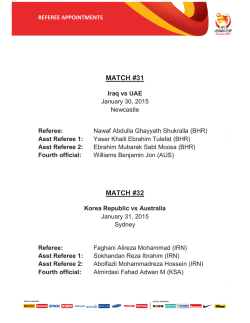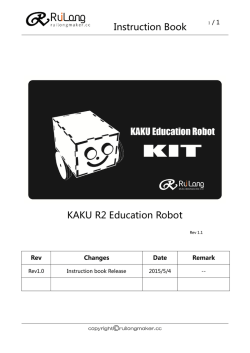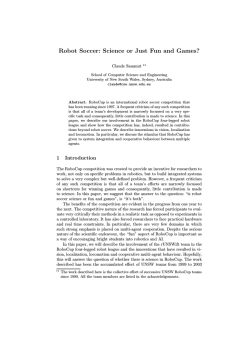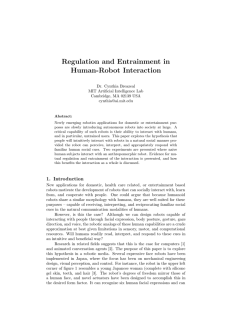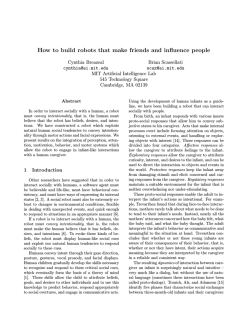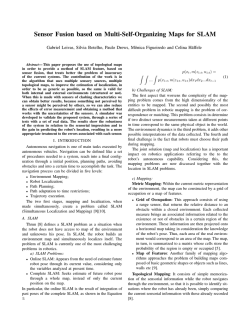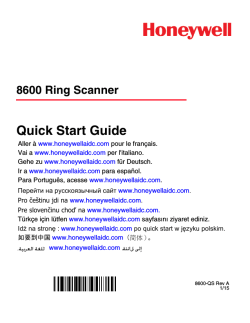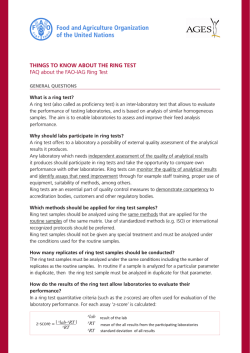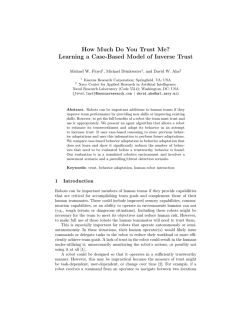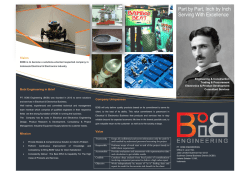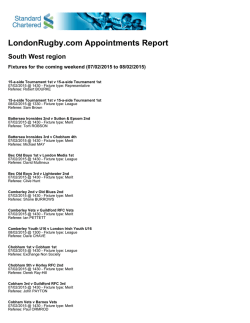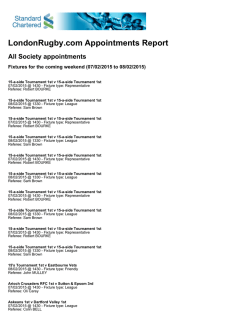
Competition Rules - t4 - Technology Subjects Support Service
Robot Games Ireland Tournament Wednesday 29th April 2015 Radisson Blu Hotel, Galway City 2015 Mini Sumo Tournament Rules 1. Definition of the Sumo Match 1.1. Definition A match is fought between two teams, each team having one or more contestants. Only one team member may approach the ring; other team members must watch from the audience. In accordance with the game rules (hereafter referred to as "these rules",) each team competes on a dohyo (Sumo ring) with a robot that they have constructed themselves to the specifications in Section 2. The match starts at the event MC’s command and continues until a contestant earns two Yuhkoh points. The individual dohyo referee determines the winner of the match on each dohyo. 2. Requirements for Robots 2.1. General Robot Specifications a) A robot must fit within a square footprint of 10cm x 10cm. There no restriction on height. b) The total mass of a robot at the start of a match must be under 500g c) A robot may expand in size after a match begins, but must not physically separate into pieces, and must remain a single centralized robot. Robots violating these restrictions shall lose the match. Screws, nuts, and other robot parts with a total mass of less than 5 g falling off from a robot's body shall not cause the loss of match. d) All robots must be autonomous. Any control mechanisms can be employed, as long as all components are contained within the robot and the mechanism does not interact with an external control system (human, machine, or otherwise). e) The robot gets a number for registration purposes. Display this number on your robot to allow spectators and officials to identify your robot. f) All robots should use the same motors (RVFM 1:120 Inline Motor & Gearbox) and control board (GENIE E18) as those used in the t4 prototype Mini Sumo Robot introduced during inservice 2012/2013. This rule is to ensure a financial level playing pitch for this year. For example, these can be purchased from Rapid Electronics here: http://www.rapidonline.com/Electrical-Power/120-1-Inline-motor-and-gearbox81728 http://www.rapidonline.com/Electronic-Components/Genie-E18-Motor-Kit-13-6016 g) Robots may use any wheels, sensors etc. as long as they comply with Rule 2.1 a) & b). 2.2. Robot Restrictions a) Jamming devices, such as IR LEDs intended to saturate the opponents IR sensors, are not allowed. b) Parts that could break or damage the ring are not allowed. Do not use parts that are intended to damage the opponent’s robot or its operator. Normal pushes and bangs are not considered intent to damage. c) Devices that can store liquid, powder, gas or other substances for throwing at the opponent are not allowed. d) Any flaming devices are not allowed. e) Devices that throw things at your opponent are not allowed. f) Sticky substances to improve traction are not allowed. Tires and other components of the robot in contact with the ring must not be able to pick up and hold a standard A4 paper (80 g/m2) for more than two seconds. g) Devices to increase down force, such as a vacuum pumps and magnets are not allowed. h) All edges, including but not limited to the front scoop, must not be sharp enough to scratch or damage the ring, other robots, or players. In general, edges with a radius of greater than 0.1 mm, as would be obtained with an unsharpened 0.2 mm thick metal strip, should be ok. Referees or competition officials may require edges that they deem too sharp to be covered with a piece of tape. 3. Requirements for the Dohyo (Sumo Ring) 3.1. Dohyo Interior The dohyo interior is defined as the playing surface surrounded by and including the border line. Anywhere outside this area is called the dohyo exterior. 3.2. Dohyo Specifications a) The ring shall be circular in shape and have a diameter of 77cm and made of wood. b) The border line is marked as a white circular ring of a width 2.5cm on the outer edge of the playing surface. The ring area extends to the outside edge of this circular line. c) For all given dohyo dimensions a tolerance of 5% applies. 3.3. Doyho Exterior Everything outside the dohyo interior is defined as dohyo exterior. Competition dohyos will be supplied at the tournament placed on two rows of large tables as shown below underneath a lighting rig. The table is big enough to ensure that operators are far enough back from the robots so as not to affect IR sensors. 4. Sumo Matches 4.1. Match Scoring a) One match shall consist of 3 rounds, within a maximum time of 5 minutes, unless extended by the referees. b) The team who wins two rounds or receives two Yuhkoh points first, within the time limit, shall win the match. A team receives a Yuhkoh point when they win a round. If the time limit is reached before one team can get two Yuhkoh points, and one of the teams has received one Yuhkoh point, the team with one Yuhkoh point shall win. c) When the match is not won by either team within the time limit, an extended match may be fought, during which the team who receives the first Yuhkoh point shall win. Alternatively, the winner/loser of the match may be decided by referees, by means of lots, or by a rematch. d) One Yuhkoh point shall be given to the winner when the referees' decision was called for or lots were employed. 5. Start, Stop, Resume, End a Match 5.1. Robot Placing Upon the referee's instructions, the two teams approach the ring to place their robots on the ring. A cross in the middle divides the sumo ring into 4 quadrants. Robots must be placed in 2 opposing quadrants as shown, with their IR sensors facing away from the opposing robot and the operators. The robots can be placed anywhere within the quadrant. The referee will remove the cross after positioning of the robots. After placing, the robots may not be moved anymore. OPERATOR IR Sensor facing away from robot operators IR Sensor facing away from robot operators OPERATOR 5.2. Starting a round The following new start procedure for the 2015 tournament was agreed with all existing 2014 coaches in Sept 2015: 1. The event MC announces that countdown is about to begin and operators push/hold down their reset buttons. 2. The MC counts down using “3, 2, 1, SUMO !” and operators release their reset buttons. 3. If a robot obviously activates before the countdown is complete then that individual dohyo referee will restart once with a new countdown for that dohyo. 4. If the same robot obviously activates again before the countdown is complete then that dohyo referee informs the head referee and the offending team may lose that round unless the problem can be rectified within the 5 minute match time. 5.3. Stop, Resume The match stops and resumes when a referee announces so. 5.4. End The match ends when the referee announces so. The two teams retrieve the robots from the ring area. 6. Time of Match 6.1. Duration Each match will be fought for a total of 5 minutes, starting and ending upon the referee's command. 6.2. Extension An extended match, if called for by the referee, shall last for a maximum of 3 minutes. 6.3. Time Keeping The following are not included in the time of the match: a) The time elapsed after a referee announces to stop the match and before the match resumes. 7. Scoring One Yuhkoh point shall be given when: a) A team legally forces the body of the opposing robot to touch the space outside the dohyo, which includes the side of the dohyo itself. b) The opposing robot has touched the space outside the dohyo on its own. When referees' decision is called for to decide the winner, the following points will be taken into consideration: c) Technical merits in movement and operation of a robot. d) Penalty points during the match. e) Attitude of the players during the match. The match shall be stopped and a rematch started under the following conditions: f) The robots are entangled or orbiting each other with no perceivable progress for 5 seconds. If it is unclear whether progress is being made or not, the referee can extend the time limit for observable progress for up to 30 seconds. g) Both robots move, without making progress, or stop (at the exact same time) and stay stopped for 5 seconds without touching each other. However, if one robot stops its movement first, after 5 seconds it will be declared as not having the will to fight. In this case the opponent shall receive a Yuhkoh, even if the opponent also stops. If both robots are moving and it isn't clear if progress is being made or not, the referee can extend the time limit up to 30 seconds. h) If both robots touch the outside of the ring at about the same time, and it cannot be determined which touched first, a rematch is called. 8. Violations 8.1. Violations Players performing any of the deeds described in Sections 2.2, 8.2 or 8.3 shall be declared in violation of these rules. 8.2. Insults A player who utters insulting words to the opponent or to the referees or puts voice devices in a robot to utter insulting words or writes insulting words on the body of a robot, or performs any insulting action, is in violation of these rules. 8.3. Minor Violations A minor violation is declared if a player: a) Enters into the ring during the match, except when the player does so to take the robot out of the ring upon the referee's announcement of Yuhkoh or stopping the match. To enter into the ring means: a. A part of the player's body is in the ring. b. A player puts any mechanical kits into the ring to support his/her body. b) Performs the following deeds: a. Demands to stop the match without appropriate reasons. b. Takes more than 30 seconds before resuming the match, unless the referee announces a time extension. c. Does or says that which disgraces the fairness of the match. 9. Penalties 9.1. Penalties a) Players who violate these rules by performing the deeds described in Sections 2.2 and 8.2 shall lose the match. The referee shall give two Yuhkoh points to the opponent and order the violator to clear out. The violator is not honoured with any rights. b) Each occasion of the violations described in Sections 8.3 shall be accumulated. Two of these violations shall give one Yuhkoh to the opponent. c) The violations described in Article 8.3 shall be accumulated throughout one match. 10. Injuries and Accidents during the Match 10.1. Request to Stop the Match A player can request to stop the game when he/she is injured or his/her robot had an accident and the game cannot continue. The referee will decide on the outcome in this event. 10.2. Unable to Continue the Match When the game cannot continue due to player's injury or robot's accident, the player who is the cause of such injury or accident loses the match. When it is not clear which team is such a cause, the player who cannot continue the game, or who requests to stop the game, shall be declared as the loser. 10.3. Time Required to Handle Injury/Accident Whether the game should continue in case of injury or accident shall be decided by the individual dohyo referee with assistance from the head referee if necessary. The decision process shall take no longer than five minutes. 10.4. Yuhkoh Given to the Player who Cannot Continue The winner decided based on Section 10.2 shall gain two Yuhkoh points. The loser who already gained one Yuhkoh point is recorded as such. When the situation under Section 10.2 takes place during an extended match, the winner shall gain one Yuhkoh point. 11. Declaring Objections 11.1. Declaring Objections a) No objections shall be declared against the individual dohyo referees' decisions. b) The lead person of a team can present objections to the head referee, before the match is over, if there are any doubts in the exercising of these rules. 12. Miscellaneous 12.1. Flexibility of Rules a) As long as the concept and fundamentals of the rules are observed, these rules shall be flexible enough to encompass the changes in the number of players and of the contents of matches. b) Modifications or abolition of the rules can be made by the local event organisers as long as they are published prior to the event, and are consistently maintained throughout the event. 12.2 Liability a) Participating teams are always responsible for the safety of their robots and are liable for any accidents caused by their team members or their robots. b) The organising Committee and the organising team members will never be held responsible or liable for any incidents and / or accidents caused by participating teams or their equipment. Please ensure that all team members have read and understood these rules. Any queries on the rules should be sent to: [email protected]
© Copyright 2024
